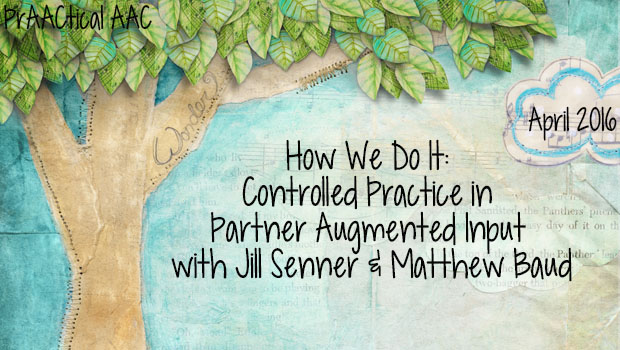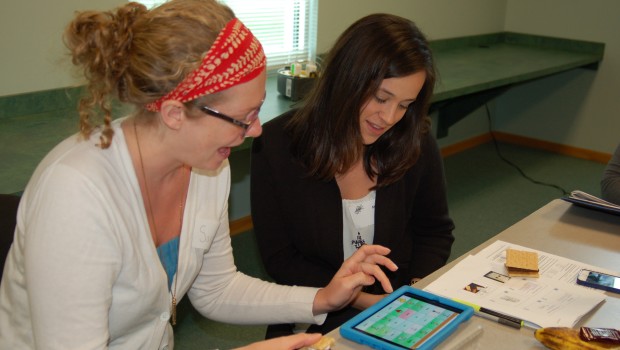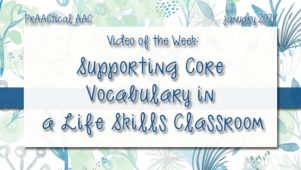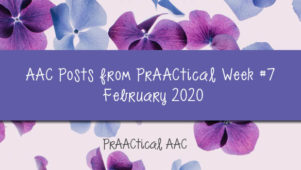How We Do It: Controlled Practice in Partner Augmented Input with Jill Senner & Matthew Baud

Today, we welcome back Dr. Jill Senner and Matthew Baud to talk about some of their strategies for implementing AAC. They have some great ideas for helping partners better support AAC learners. You can read some of their previous posts here. In the meantime, let’s see how they are helping communication partners develop their AAC facilitation skills.
::::::::::::::::::::::::::::::::::::::::::::::::::::::::::::

Most of us already know that evidence-based research supports the use of partner-augmented input (PAI) as an intervention strategy for individuals who use AAC. However, simply having awareness of a strategy does not mean that one can easily use it. To quote Jim Knight, “We wouldn’t teach someone to drive by giving them a lecture, tossing them a book, and then turning them loose on the freeway.” Indeed, in order to learn a new skill, communication partners often need practice. In fact, one may need to try a new strategy or skill up to 20 times in a simulated condition before one can transfer the skill to the natural environment.
School-aged children spend roughly 30 hours a week attending school, making school staff members (e.g., therapists, teachers, paraprofessionals) key communication partners in the educational environment. In schools, controlled practice opportunities allow staff to first perform PAI without the distractions and pressures of the classroom.

Sara Shook, Teacher & Maggie Long, SLP from the Classroom Connection Day School practice PAI on an iPad with TouchChat during a training.
When providing instruction in partner-augmented input, we use the SMoRRES mnemonic to help communication partners remember all of the steps involved. An important component of Mo (modeling) is parallel talk, a technique in which an adult talks about what a child is seeing, hearing, doing, or feeling, as the child is doing it. This is like providing the color commentary for an activity in which the child is engaged. For example, as the child is playing with blocks, the adult might narrate, “Uh oh, the blocks fell down.”
Thinking about what to say in the moment and then quickly modeling it on a student’s speech-generating device or communication board frequently requires practice. We lead teams through controlled practice in parallel talk using a variety of resources, including our Parallel Talk Lab, which is now available free to the public on YouTube.
:::::::::::::::::::::::::::::::::::::::::::::::::::::::::::::::::::::::
Jill E Senner can be reached at:
@JillESenner, http://www.talcaac.com/. https://www.facebook.com/TechnologyLanguageCenterInc/, https://www.pinterest.com/talcaac/
Matthew R. Baud can be reached at:
@mbaud12, https://sites.google.com/a/ntdse.org/assistivetechnology/home
Filed under: Featured Posts, PrAACtical Thinking
Tagged With: augmented input, classroom, partner training, schools
This post was written by Carole Zangari





2 Comments
Working as a Vice Principal of a high school with an inclusive OI program, many of our students use AAC’s to communicate throughout their day. Many of the students use different types of AAC’s (Dynavox, eye gaze, even iPad’s) and it can be hard to keep up. Just today one of our students found himself stuck in the hall as he was transitioning from lunch to class. His 1-1 had already left for the day because we are on an odd testing schedule so a random teacher flagged me down. I went to assist the student and it turned out his chair was a bit toasty from the CA spring sun and would not reset. I naturally went through the different steps of SMoRRES without knowing it and was able to locate his teacher who helped me get his chair in manual mode. While I naturally am able to follow the steps of SMoRRES, many of our teachers are still learning. This is a great way for me to get them a simple tool to assist in moments of need. Thanks!
Hi Shannon,
Thanks for your feedback. We’re glad you have found the tools here helpful but appreciate that it can be “hard to keep up” with modeling across different devices and staff members. Over the years we have become acutely aware that getting all staff modeling on students’ devices requires the use of *multiple* training elements. Verbal practice (SMoRRES) and controlled practice are only 2 steps of a systematic 8-step instructional protocol (Kent-Walsh & McNaughton, 2005) that we have adapted to help teams learn to provide partner-augmented input in the classroom. Most of the training occurs in the actual classroom with coaches present, which is a critical component of controlled and advanced practice. We have conference handouts and articles that provide more details on our use of the training protocol and data on its use at talcaac.com – our research paper is still in press but we expect that to be available soon as well. Hopefully you will find these additional materials helpful in supporting modeling in your school.
Sincerely,
Jill & Matt